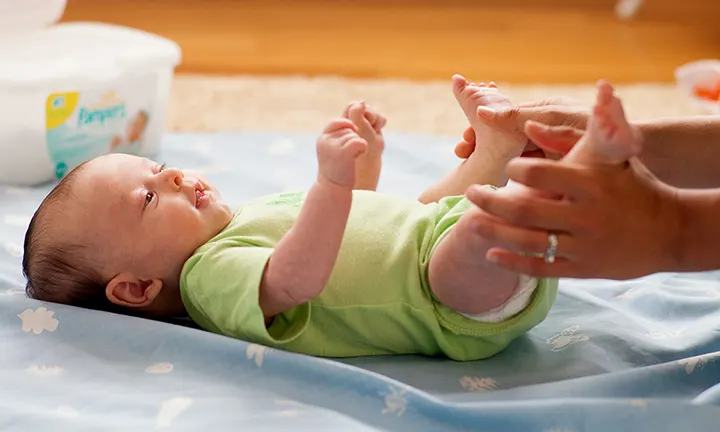Diaper Size and Weight Chart Guide
Wondering which diaper size to choose for your little one? To help you make this important decision, Pampers worked with thousands of babies and their parents, taking nearly a half-million diaper-fit measurements to create just the right range of sizes for every family. We want to make it easier to find the perfect diaper for your growing baby, and our research resulted in a diaper size and weight chart to guide you in the right direction!
How Diaper Sizes Work
First, it helps to understand how diaper sizes work. A common question among parents is how to read a diaper size chart by age; however, age isn’t the ideal factor to consider. Instead, after taking hundreds of thousands of measurements, Pampers has organized diaper size by weight to help you select the right diaper. As you’re looking at the diaper size comparison chart below, keep in mind that your little one’s weight will be the most important factor.
We’ve also included information on our diaper size comparison chart to help answer two common questions:
Should you buy a specific number of diapers in each size? You might prefer to wait and see, as babies grow at different rates. But for general planning purposes, we've included the average number of diapers a baby uses for most sizes on our chart. How many diapers your baby needs per day may surprise you, whether you’re buying newborn diaper sizes or larger sizes.
How many months do babies need a specific diaper size? In addition to knowing how many diapers you’ll need, you might want to know how long your little one will wear each size. We’ve also included the average number of months babies typically wear each size. For example, many infants wear a newborn diaper size for about a month and a half.
Pampers Baby Diaper Size Chart by Weight
To sum up Pampers’ work with thousands of families, we’ve put together a simple diaper size chart (covering most sizes) that you can use as a quick guide to finding the best diaper size for your baby:
*Can vary by baby, age, and individual habits and practice To find a diaper size for your baby, look for your baby’s weight (which you can determine at home or obtain from your child’s healthcare provider at each well-baby visit). For example, a size 1 diaper’s weight range is for a baby who is between 8 and 14 pounds, whereas a size 2 diaper’s weight range is between 12 and 18 pounds.
Since these weight ranges can overlap in different diaper sizes, keep reading to learn more about how to find a good fit, when to size up diapers, and which Pampers diaper is best for your little one. Plus, pick up some tips on how to help prevent leaks and blowouts.
How to Weigh Your Baby
Pampers diaper sizes are determined by weight, and you may be wondering how to weigh your baby at home. You can use a standard bathroom scale and follow these basic steps to weigh your baby:
Take off your baby’s clothes and diaper, and then step on the scale while holding your little one.
Record the number.
Then, step back on the scale without your baby.
Subtract the second number from the first number to get your baby’s weight. Voilà!
Of course, your baby’s healthcare provider will also weigh and measure your baby at each checkup. Learn more about how your little one might grow and change in size with our baby growth calculator below!
Diaper Size Guide: How to Get the Right Fit
Babies come in all sizes and shapes, so diapers fit a little differently on every child. Pampers diaper sizes go by your baby’s weight—not age or gender—as weight is the most accurate way to determine the correct fit. Most of the time, your baby's weight will fall neatly within the range of a certain diaper size, producing a good fit. But in some cases, you might need to choose between two sizes, as the weight ranges can overlap.
For example, a size 4 diaper’s weight range is between 22 and 37 pounds, a size 5 diaper’s weight range is over 27 pounds, and a size 6 diaper’s weight range is above 35 pounds. There’s a lot of overlap there! Once you’ve selected a diaper size by your baby’s weight, then try these four quick checks to ensure a proper fit:
The diaper’s waistband should sit just under your baby’s belly button.
The leg cuffs shouldn’t have any gaps. After the diaper is on, run two fingers just inside the leg cuffs to remove any gaps, which can help prevent leaks.
After fastening the diaper, you should be able to fit two fingers under the waistband. This means the diaper fits correctly—not too snug, not too loose.
You shouldn’t see any red marks on your baby’s skin when you take the diaper off.
When to Size Up Diapers
Besides an increase in weight, there are additional signs that your baby might be ready for a larger diaper size. The following guidelines can help ensure your little one is wearing the correct diaper size:
If the fastening tapes don't reach the center of the waistband, it's time for a bigger size; if the tapes overlap, the diaper may be too big.
If you can't comfortably fit two fingers under the waistband of the fastened diaper, it's time for a bigger size.
You may need to go up a size if you notice red marks on your baby's tummy or thighs when you remove the diaper.
If the diaper isn't fully covering your baby's bottom, choose a bigger size.
If your baby regularly gets diaper rash, it may be because the diaper is too small and doesn’t keep the moisture away from their skin.
The diaper may be too small if your baby shows signs of distress (for example, pulling at the diaper).
Test your knowledge and pick up even more tips on how to choose the correct Pampers diaper size with our quiz below!
Which Pampers Diaper Is Best for My Baby?
Diaper needs will change as your baby grows, becomes more active, and approaches different development milestones. Pampers offers a full lineup of diapers and pants to support your little one at every age and stage of development.
Here are some things to consider when choosing which Pampers product to buy:
For Newborns
As newborns have very delicate skin (and need gentle materials and appropriate skin care), look for a diaper that's
very soft
super absorbent to keep your baby's skin dry
designed so it doesn't rub against the umbilical cord stump
easy to put on and fasten.
You'll find newborn diaper sizes in Pampers Swaddlers, Pampers Pure Protection, and Pampers Baby-Dry.
For Growing Babies
Dryness will be your biggest focus when your little one is around 6 to 12 months old, and choosing the correct fit is key to preventing leaks as you transition diaper sizes. For growing babies, choose a diaper that’s
super absorbent to keep your baby’s skin dry
designed to move with your baby
easy to put on and take off.
At this stage, consider Pampers Swaddlers 360°, Pampers Cruisers 360°, or Pampers Baby-Dry, which all come in diaper sizes 3 to 6 (and size 7 for Pampers Baby Dry and Cruisers 360°).
For On-the-Go Babies
When your little one is wiggling or crawling, beginning to walk, or running with ease, you’ll need something that you can change in a hurry. So, with active babies, consider diapers or pants that are
easy to take off quickly
move with your baby as they play, run, and crawl around
extra absorbent and keep your baby’s skin dry.
For example, you might like Pampers Swaddlers 360°, Pampers Cruisers 360° or Pampers Easy Ups.
For Overnight Protection and Swimming Convenience
Although all Pampers diapers and pants are designed with optimal absorption and leak protection, the following are best for swimming and overnight protection.
Pampers Swaddlers Overnights offer extra absorption, breathability, and softness for a comfortable snooze.
Pampers Splashers are highly absorbent without swelling, so the fit and feel don’t change when your little one is playing in the water.
This chart summarizes available sizes for each product (and includes swim diaper sizes, too) to help you select the right Pampers diapers or pants:
Why the Right Size Matters
When your baby wears the correct diaper size, good things happen! A well-fitting diaper in the right size will be more comfortable for your baby and can help prevent leaks and blowouts from occurring.
Here's what could happen if your little one isn’t wearing the correct diaper size:
If a diaper is too small, it can leak because there isn’t enough absorbency for the volume of baby poop or pee. The diaper can’t properly do its job, and moisture can irritate your baby’s skin.
If the leg cuffs don’t fit properly or are tucked inside the diaper, pee can leak out the sides.
If a diaper is too big, baby pee and poop may leak out of the gaps before the diaper can absorb it, leading to skin irritation.
By choosing the correct diaper size, you’re helping your baby stay dry, comfortable, healthy, and clean.
The Bottom Line
Once you find the best fit for your little one using our diaper size chart and know how to change a diaper like a pro, selecting the right fit will be a breeze. Your baby will be comfier, and you'll feel confident that your little one will have fewer problems with leaks or blowouts. Still, accidents happen, so stay well-stocked with our diaper bag checklist to prepare for all situations.
Don’t forget to reward yourself for all those diaper changes with the Pampers Club app, which offers Pampers Cash for all purchases of diapers and baby wipes.
How We Wrote This Article The information in this article is based on the expert advice found in trusted medical and government sources, such as the American Academy of Pediatrics and the American College of Obstetricians and Gynecologists. You can find a full list of sources used for this article below. The content on this page should not replace professional medical advice. Always consult medical professionals for full diagnosis and treatment.
Join a World of Support
through Pregnancy and Parenthood.
TRACK WITH TOOLS
LEARN WITH EXPERTS
GET REWARDED












